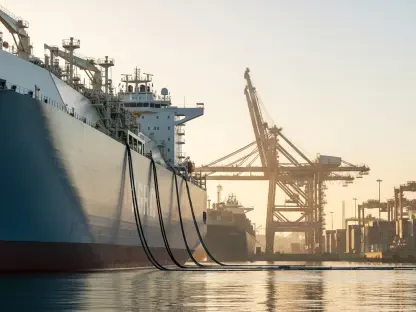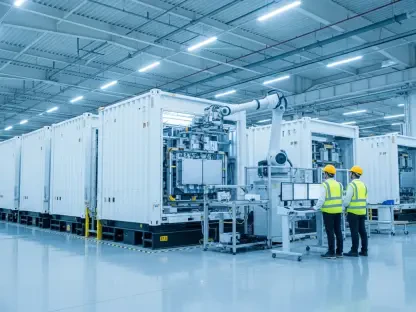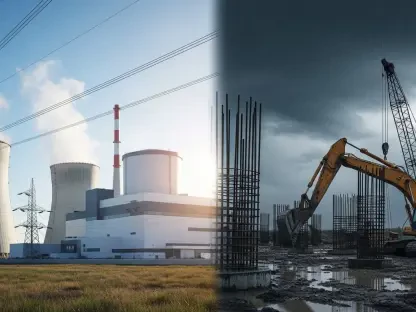In response to dwindling water reserves in hydroelectric dams, Colombia has significantly increased its imports of Liquefied Natural Gas (LNG). This strategic shift underscores the vulnerability of the country’s energy grid and highlights the importance of LNG in ensuring a stable electricity supply. Hydroelectric power has traditionally formed the backbone of Colombia’s electricity generation, accounting for approximately 70% of the nation’s total supply. However, the country’s reservoirs have reached a dangerously low level, hitting 50.2%, a historic low that has crippled hydroelectric output. This severe decline in water reserves has necessitated urgent measures to fill the energy gap, leading to a surge in LNG imports.
Surging LNG Imports Amid Hydroelectric Decline
Faced with plummeting water levels and an urgent need to stabilize its electricity grid, Colombia’s energy authorities have significantly ramped up LNG imports. In September 2024 alone, the country imported 150,000 metric tons of LNG, marking a notable increase from the 120,000 metric tons imported in the same month the previous year. This uptick in LNG imports is crucial for thermal power plants, which serve as backup power sources when hydroelectric output falls short.
Key to this strategy is the SPEC LNG’s Cartagena terminal, which plays a pivotal role in facilitating the arrival and distribution of LNG shipments from various international sources. Tankers such as the Marvel Crane and BW Magnolia deliver substantial quantities of LNG to this terminal, ensuring a steady supply to meet the country’s energy demands. The Cartagena terminal’s capacity to handle these shipments smoothly is vital for ensuring that Colombia can quickly adapt to fluctuating hydroelectric outputs. By maintaining a robust supply chain and infrastructure for LNG, Colombia aims to safeguard against future energy shortfalls, thereby preventing potential blackouts and economic disruptions.
Impact of El Niño and Electrical Demand
Although the El Niño phenomenon technically concluded in May 2024, its lingering effects are still felt, as the water levels in Colombia’s reservoirs have not sufficiently recovered. This ongoing stress on the energy grid underscores the urgency for increased LNG imports to maintain a stable electricity supply. Weather patterns exert a significant influence on the demand for energy, further exacerbating the challenges faced by Colombia’s energy sector. The unpredictable nature of climate events like El Niño emphasizes the necessity for diversified energy sources to mitigate such risks effectively.
With hydroelectric power compromised, LNG has emerged as a reliable alternative to ensure consistent electricity, particularly during periods of heightened demand and climatic irregularities. The need to diversify energy sources is not merely about immediate crisis management but also about long-term resilience. As climate patterns continue to grow more unpredictable, Colombia’s energy strategy will need to become increasingly adaptive. The integration of LNG has proven to be an effective short-term measure, but the ongoing challenge is to develop a balanced and sustainable energy portfolio that can withstand future environmental stresses.
Strategic LNG Procurement and Storage
Colombia’s strategy for managing its LNG imports is multifaceted, addressing both the procurement and storage of LNG. Low domestic natural gas production levels necessitate a reliance on the international market for LNG, sourced from varied locations including the Cameron LNG terminal in Louisiana. This diverse procurement approach is designed to strengthen Colombia’s energy security by mitigating risks associated with over-reliance on a single source or region. Efficient management of LNG imports is crucial to balancing supply with real-time energy demands, which are heavily influenced by weather conditions and industrial consumption patterns.
To ensure energy grid stability, Colombia adopts flexible LNG storage solutions that can accommodate supply and demand fluctuations. The strategy involves strategically unloading LNG cargoes in stages, aligning supply with immediate requirements. This method not only prevents overstocking but also optimizes the usage of imported LNG, thereby ensuring that the electricity grid remains stable. Moreover, the logistical efficiency of these operations reduces the risk of storage bottlenecks and supply chain disruptions. By meticulously planning and executing LNG imports and storage, Colombia aims to create a resilient system capable of responding dynamically to both seasonal and unexpected energy needs.
Challenges in Energy Model Sustainability
The increasing reliance on LNG as a supplement to the hydroelectric shortfall raises questions about the long-term sustainability of Colombia’s energy model. The structural challenges are significant, particularly in balancing hydroelectric power, domestic natural gas, and imported LNG to create a sustainable and resilient energy portfolio. Climatic variability further complicates this balancing act, highlighting the necessity for a comprehensive rethinking of long-term energy strategies. The economic factors involved in this complex equation are also critical. The costs associated with importing LNG are substantial, and the need to stabilize electricity supply makes adaptive and proactive energy management all the more important.
Sustainability concerns are accentuated by the fact that Colombia’s current energy model is highly susceptible to external shocks, both in terms of climatic and market conditions. An over-reliance on LNG imports exposes the nation to global price fluctuations and supply chain uncertainties, necessitating robust contingency plans. Moving forward, it is imperative for Colombia to explore renewable energy alternatives and enhance the efficiency of existing infrastructure. Investments in solar, wind, and other renewable energy sources could provide a more sustainable and resilient framework for the country’s energy needs. By adopting a holistic approach to energy planning, Colombia can mitigate the inherent risks associated with its current model and build a more secure and sustainable energy future.
Long-Term Implications and Future Strategies
As Colombia navigates this complex energy landscape, the integration of LNG into its energy mix has sparked a necessary debate on the country’s long-term strategy. While the reliance on international LNG markets provides a critical stopgap measure, it also exposes the nation to vulnerabilities related to global price fluctuations and supply chain uncertainties. To address these challenges, Colombia must develop robust contingency plans and seek to diversify its energy portfolio further. Exploring renewable energy alternatives and improving the efficiency of existing infrastructure are critical steps forward.
Investments in renewable energy sources such as solar and wind power could significantly contribute to a more sustainable and resilient energy framework. Additionally, collaborating with international partners to develop cutting-edge energy solutions may offer pathways to mitigate future vulnerabilities effectively. By fostering innovation and embracing renewable energy technologies, Colombia can reduce its dependency on imported LNG and promote environmental sustainability. This strategic pivot not only aligns with global trends toward cleaner energy but also enhances the country’s energy security.
Balancing Immediate Needs with Future Goals
Facing significantly reduced water reserves in its hydroelectric dams, Colombia has substantially ramped up its imports of Liquefied Natural Gas (LNG). This strategic pivot underscores the vulnerability of Colombia’s energy infrastructure and highlights the crucial role that LNG now plays in maintaining a stable electricity supply. Historically, hydroelectric power has been the cornerstone of Colombia’s energy production, providing roughly 70% of the country’s electricity. However, the water levels in Colombia’s reservoirs have plummeted to 50.2%, a historic low that has severely hampered hydroelectric output. This alarming drop in water reserves has made it imperative for the country to take urgent measures to address the energy shortfall, resulting in a notable increase in LNG imports. The move to import more LNG is not just a temporary fix but also an essential step to diversify the country’s energy sources. Ensuring a reliable supply of electricity is critical for Colombia’s economic stability and growth. As the nation navigates this energy crisis, it underscores the need for a more resilient and varied energy strategy to mitigate similar risks in the future.









